The Energy Conversion and Coupling Technologies of Hybrid Wind–Wave Power Generation Systems: A Technological Review
Abstract
:1. Introduction
2. Energy Conversion Technologies
2.1. Wind Energy Conversion Technologies
2.1.1. Mechanical–Electrical Schemes
2.1.2. Mechanical–Hydraulic Schemes
2.2. Wave Energy Conversion Technologies
2.2.1. Oscillating Bodies Systems
2.2.2. Oscillating Water Column Systems
2.2.3. Overtopping System
3. Energy Coupling Technologies
3.1. Electrical Coupling
3.1.1. AC Coupling
AC Microgrid Technology
Novel Control Strategies
3.1.2. DC Coupling
DC Microgrid Technology
Novel Control Strategies
3.1.3. Energy Storage Technology
3.2. Hydraulic Coupling
3.2.1. Multi-Generator Schemes
3.2.2. Single-Generator Schemes
4. Discussion
4.1. Wind Energy Conversion Technologies
4.2. Wave Energy Conversion Technologies
| Scheme | Advantages | Disadvantages |
|---|---|---|
| OBs |
| |
| OWCs |
|
|
| Overtopping |
|
|
4.3. Energy Coupling Technologies
4.4. Seasonal Influences
4.5. Technological Gaps
- Short operating lives. Most hybrid wind–wave systems employ OBs. Damage to their mechanical components significantly decreases their operating life.
- Low energy production. The development of energy conversion and coupling technologies for hybrid wind–wave systems is still in its early stages. Energy production has not yet reached its maximum level.
- Limited economic viability. High maintenance costs reduce the economy of these systems.
- Scarcity of theoretical research and experimental tests. At present, there are a limited number of studies on the energy conversion and coupling technologies of hybrid wind–wave systems. The existing numerical models and experimental studies are not sufficient to support their further development.
4.6. Technology Development Forecasts
5. Conclusions
- (1)
- Mechanical–electrical wind energy conversion schemes account for a large proportion of existing hybrid wind–wave systems. However, mechanical–hydraulic schemes have more prominent advantages, including compact sizes, simple control methods, high reliability, high energy transmission efficiency, and low economic costs.
- (2)
- The use percentages of different wave energy conversion schemes from 2012 to 2023 were presented. The percentages schemes implementing OBs, OWCs, and overtopping systems were 58%, 34%, and 8%, respectively.
- (3)
- Of the different wave energy conversion technologies, OWCs have the most balanced LCOE. Integrating oscillating water column devices and hydraulic wind turbines into hybrid wind–wave systems is the most promising choice.
- (4)
- The distribution of the different PTO systems applied to the OBs in existing hybrid wind–wave systems from 2012 to 2023 was presented. Hydraulic PTO systems account for 73% of OBs, whereas direct-drive PTO systems account for 27%.
- (5)
- DC and hydraulic coupling are expected to become mainstream schemes in the future. There remains a large innovative space for energy coupling technologies.
- (6)
- Seasonal factors are crucial for the sustainable development of hybrid wind–wave power generation systems.
- (7)
- Existing challenges in energy conversion and coupling technologies include their short operating life, low energy production, limited economic viability, and the scarcity of theoretical research and experimental tests.
Author Contributions
Funding
Acknowledgments
Conflicts of Interest
References
- Poudyal, R.; Loskot, P.; Nepal, R.; Parajuli, R.; Khadka, S.K. Mitigating the current energy crisis in Nepal with renewable energy sources. Renew. Sustain. Energy Rev. 2019, 116, 109388. [Google Scholar] [CrossRef]
- Rellán, A.G.; Ares, D.V.; Brea, C.V.; López, A.F.; Bugallo, P.M.B. Sources, sinks and transformations of plastics in our oceans: Review, management strategies and modelling. Sci. Total Environ. 2022, 854, 158745. [Google Scholar] [CrossRef] [PubMed]
- Li, M.; Luo, H.; Zhou, S.; Senthil Kumar, G.M.; Guo, X.; Law, T.C.; Cao, S. State-of-the-art review of the flexibility and feasibility of emerging offshore and coastal ocean energy technologies in East and Southeast Asia. Renew. Sustain. Energy Rev. 2022, 162, 112404. [Google Scholar] [CrossRef]
- Chakraborty, S.; Dwivedi, P.; Chatterjee, S.K.; Gupta, R. Factors to Promote Ocean Energy in India. Energy Policy 2021, 159, 112641. [Google Scholar] [CrossRef]
- Chakraborty, S.; Dwivedi, P.; Gupta, R.; Yadavalli, N. Review of Global Ocean Energy Policies in View of Lessons for India. 2018. Available online: https://www.iea.org/reports/india-2020 (accessed on 4 April 2024).
- Galdies, C.; Bellerby, R.; Canu, D.; Chen, W.; Garcia-Luque, E.; Gašparović, B.; Godrijan, J.; Lawlor, P.J.; Maes, F.; Malej, A.; et al. European policies and legislation targeting ocean acidification in european waters—Current state. Mar. Policy 2020, 118, 103947. [Google Scholar] [CrossRef]
- Ma, C.L. Ocean Energy Management Policy in China. Procedia Comput. Sci. 2019, 154, 493–499. [Google Scholar] [CrossRef]
- de Matos Sá, M.; Correia da Fonseca, F.X.; Amaral, L.; Castro, R. Optimising O&M scheduling in offshore wind farms considering weather forecast uncertainty and wake losses. Ocean Eng. 2024, 301, 117518. [Google Scholar]
- Costoya, X.; deCastro, M.; Carvalho, D.; Feng, Z.; Gómez-Gesteira, M. Climate change impacts on the future offshore wind energy resource in China. Renew. Energy 2021, 175, 731–747. [Google Scholar] [CrossRef]
- Hoeser, T.; Kuenzer, C. Global dynamics of the offshore wind energy sector monitored with Sentinel-1: Turbine count, installed capacity and site specifications. Int. J. Appl. Earth Obs. Geoinf. 2022, 112, 102957. [Google Scholar] [CrossRef]
- Ai, C.; Zhang, L.; Gao, W.; Yang, G.; Wu, D.; Chen, L.; Chen, W.; Plummer, A. A review of energy storage technologies in hydraulic wind turbines. Energy Convers. Manag. 2022, 264, 115584. [Google Scholar] [CrossRef]
- Liu, X.; Li, N.; Mu, H.; Li, M.; Liu, X. Techno-energy-economic assessment of a high capacity offshore wind-pumped-storage hybrid power system for regional power system. J. Energy Storage 2021, 41, 102892. [Google Scholar] [CrossRef]
- Wu, Y.; Zhang, T. Risk assessment of offshore wave-wind-solar-compressed air energy storage power plant through fuzzy comprehensive evaluation model. Energy 2021, 223, 120057. [Google Scholar] [CrossRef]
- Zhang, Y.; Ma, C.; Yang, Y.; Pang, X.; Lian, J.; Wang, X. Capacity configuration and economic evaluation of a power system integrating hydropower, solar, and wind. Energy 2022, 259, 125012. [Google Scholar] [CrossRef]
- Wang, Y.; Liu, Z.; Wang, H. Proposal and layout optimization of a wind-wave hybrid energy system using GPU-accelerated differential evolution algorithm. Energy 2022, 239, 121850. [Google Scholar] [CrossRef]
- Soliman, M.S.; Belkhier, Y.; Ullah, N.; Achour, A.; Alharbi, Y.M.; Al Alahmadi, A.A.; Abeida, H.; Khraisat, Y.S.H. Supervisory energy management of a hybrid battery/PV/tidal/wind sources integrated in DC-microgrid energy storage system. Energy Rep. 2021, 7, 7728–7740. [Google Scholar] [CrossRef]
- Cabrera, P.; Folley, M.; Carta, J.A. Design and performance simulation comparison of a wave energy-powered and wind-powered modular desalination system. Desalination 2021, 514, 115173. [Google Scholar] [CrossRef]
- Baykov, A.; Dar’enkov, A.; Kurkin, A.; Sosnina, E. Mathematical modelling of a tidal power station with diesel and wind units. J. King Saud Univ. Sci. 2019, 31, 1491–1498. [Google Scholar] [CrossRef]
- Astariz, S.; Iglesias, G. Output power smoothing and reduced downtime period by combined wind and wave energy farms. Energy 2016, 97, 69–81. [Google Scholar] [CrossRef]
- Wimalaratna, Y.P.; Afrouzi, H.N.; Mehranzamir, K.; Siddique, M.B.M.; Liew, S.C.; Ahmed, J. Analysing wind power penetration in hybrid energy systems based on techno-economic assessments. Sustain. Energy Technol. Assess. 2022, 53, 102538. [Google Scholar] [CrossRef]
- Castro-Santos, L.; Martins, E.; Guedes Soares, C. Economic comparison of technological alternatives to harness offshore wind and wave energies. Energy 2017, 140, 1121–1130. [Google Scholar] [CrossRef]
- Masoumi, M. Ocean data classification using unsupervised machine learning: Planning for hybrid wave-wind offshore energy devices. Ocean Eng. 2021, 219, 108387. [Google Scholar] [CrossRef]
- Qian, P.; Zhang, D.; Tian, X.; Si, Y.; Li, L. A novel wind turbine condition monitoring method based on cloud computing. Renew. Energy 2019, 135, 390–398. [Google Scholar] [CrossRef]
- Quevedo, E.; Delory, E.; Castro, A.; Llinás, O.; Hernandez Brito, J.; Consortium, T. Modular multi-purpose offshore platforms, the TROPOS project approach. In Proceedings of the 4th International Conference on Ocean Energy, Dublin, Ireland, 17–20 October 2012. [Google Scholar]
- Lakkoju, V.N.M.R. Combined power generation with wind and ocean waves. Renew. Energy 1996, 9, 870–874. [Google Scholar] [CrossRef]
- Pérez-Collazo, C.; Greaves, D.; Iglesias, G. A review of combined wave and offshore wind energy. Renew. Sustain. Energy Rev. 2015, 42, 141–153. [Google Scholar] [CrossRef]
- Schwanitz, V.J.; Wierling, A. Offshore wind investments—Realism about cost developments is necessary. Energy 2016, 106, 170–181. [Google Scholar] [CrossRef]
- Castro-Santos, L.; Filgueira-Vizoso, A.; Carral-Couce, L.; Formoso, J.Á.F. Economic feasibility of floating offshore wind farms. Energy 2016, 112, 868–882. [Google Scholar] [CrossRef]
- Patel, R.P.; Nagababu, G.; Kachhwaha, S.S.; Kumar, S.V.A.; Seemanth, M. Combined wind and wave resource assessment and energy extraction along the Indian coast. Renew. Energy 2022, 195, 931–945. [Google Scholar] [CrossRef]
- Ragab, A.M.; Shehata, A.S.; Elbatran, A.H.; Kotb, M.A. Numerical optimization of hybrid wind-wave farm layout located on Egyptian North Coasts. Ocean Eng. 2021, 234, 109260. [Google Scholar] [CrossRef]
- Gao, Q.; Khan, S.S.; Sergiienko, N.; Ertugrul, N.; Hemer, M.; Negnevitsky, M.; Ding, B. Assessment of wind and wave power characteristic and potential for hybrid exploration in Australia. Renew. Sustain. Energy Rev. 2022, 168, 112747. [Google Scholar] [CrossRef]
- Contestabile, P.; Russo, S.; Azzellino, A.; Cascetta, F.; Vicinanza, D. Combination of local sea winds/land breezes and nearshore wave energy resource: Case study at MaRELab (Naples, Italy). Energy Convers. Manag. 2022, 257, 115356. [Google Scholar] [CrossRef]
- Stoutenburg, E.D.; Jenkins, N.; Jacobson, M.Z. Power output variations of co-located offshore wind turbines and wave energy converters in California. Renew. Energy 2010, 35, 2781–2791. [Google Scholar] [CrossRef]
- Saenz-Aguirre, A.; Saenz, J.; Ulazia, A.; Ibarra-Berastegui, G. Optimal strategies of deployment of far offshore co-located wind-wave energy farms. Energy Convers. Manag. 2022, 251, 114914. [Google Scholar] [CrossRef]
- Gaughan, E.; Fitzgerald, B. An assessment of the potential for Co-located offshore wind and wave farms in Ireland. Energy 2020, 200, 117526. [Google Scholar] [CrossRef]
- Li, J.; Pan, S.; Chen, Y.; Yao, Y.; Xu, C. Assessment of combined wind and wave energy in the tropical cyclone affected region:An application in China seas. Energy 2022, 260, 125020. [Google Scholar] [CrossRef]
- Haces-Fernandez, F.; Li, H.; Ramirez, D. A layout optimization method based on wave wake preprocessing concept for wave-wind hybrid energy farms. Energy Convers. Manag. 2021, 244, 114469. [Google Scholar] [CrossRef]
- Clark, C.E.; Miller, A.; DuPont, B. An analytical cost model for co-located floating wind-wave energy arrays. Renew. Energy 2019, 132, 885–897. [Google Scholar] [CrossRef]
- Veigas, M.; Carballo, R.; Iglesias, G. Wave and offshore wind energy on an island. Energy Sustain. Dev. 2014, 22, 57–65. [Google Scholar] [CrossRef]
- Moschos, E.; Manou, G.; Dimitriadis, P.; Afentoulis, V.; Koutsoyiannis, D.; Tsoukala, V.K. Harnessing wind and wave resources for a Hybrid Renewable Energy System in remote islands: A combined stochastic and deterministic approach. In Proceedings of the European Geosciences Union General Assembly 2017: Energy, Resources and the Environment (ERE): Meeting the Challenges of the Future, Vienna, Austria, 23–28 April 2017; Elsevier Ltd.: Vienna, Austria, 2017; pp. 415–424. [Google Scholar]
- Vieira da Silva, G.; Toldo Jr, E.E.; Klein, A.H.d.F.; Short, A.D. The influence of wave-, wind- and tide-forced currents on headland sand bypassing—Study case: Santa Catarina Island north shore, Brazil. Geomorphology 2018, 312, 1–11. [Google Scholar] [CrossRef]
- Astariz, S.; Iglesias, G. Selecting optimum locations for co-located wave and wind energy farms. Part II: A case study. Energy Convers. Manag. 2016, 122, 599–608. [Google Scholar] [CrossRef]
- Villalba, J.; Abdussamie, N.; Aryai, V.; Nikolova, N.; Tenekedjiev, K.; Wang, C.-M.; Penesis, I. Assessment of uncertain alternatives for co-located aquaculture and offshore wind farm in tasmania. Ocean Eng. 2022, 249, 110949. [Google Scholar] [CrossRef]
- Astariz, S.; Vazquez, A.; Sánchez, M.; Carballo, R.; Iglesias, G. Co-located wave-wind farms for improved O&M efficiency. Ocean Coast. Manag. 2018, 163, 66–71. [Google Scholar]
- Dong, X.; Li, Y.; Li, D.; Cao, F.; Jiang, X.; Shi, H. A state-of-the-art review of the hybrid wind-wave energy converter. Prog. Energy 2022, 4, 042004. [Google Scholar] [CrossRef]
- El-Sattar, H.A.; Sultan, H.M.; Kamel, S.; Khurshaid, T.; Rahmann, C. Optimal design of stand-alone hybrid PV/wind/biomass/battery energy storage system in Abu-Monqar, Egypt. J. Energy Storage 2021, 44, 103336. [Google Scholar] [CrossRef]
- Lucas, T.R.; Ferreira, A.F.; Santos Pereira, R.B.; Alves, M. Hydrogen production from the WindFloat Atlantic offshore wind farm: A techno-economic analysis. Appl. Energy 2022, 310, 118481. [Google Scholar] [CrossRef]
- Rasool, S.; Muttaqi, K.M.; Sutanto, D.; Hemer, M. Quantifying the reduction in power variability of co-located offshore wind-wave farms. Renew. Energy 2022, 185, 1018–1033. [Google Scholar] [CrossRef]
- Giudici, F.; Garofalo, E.; Bozzi, S.; Castelletti, A. Climate uncertainty and technological innovation shape investments in renewable energy for small off-grid islands. Renew. Sustain. Energy Transit. 2022, 2, 100036. [Google Scholar] [CrossRef]
- Chen, Z.; Sun, J.; Yang, J.; Sun, Y.; Chen, Q.; Zhao, H.; Qian, P.; Si, Y.; Zhang, D. Experimental and numerical analysis of power take-off control effects on the dynamic performance of a floating wind-wave combined system. Renew. Energy 2024, 226, 120353. [Google Scholar] [CrossRef]
- Vasileiou, M.; Loukogeorgaki, E.; Vagiona, D.G. GIS-based multi-criteria decision analysis for site selection of hybrid offshore wind and wave energy systems in Greece. Renew. Sustain. Energy Rev. 2017, 73, 745–757. [Google Scholar] [CrossRef]
- Kardakaris, K.; Boufidi, I.; Soukissian, T. Offshore wind and wave energy complementarity in the greek seas based on ERA5 data. Atmosphere 2021, 12, 1360. [Google Scholar] [CrossRef]
- Haces-Fernandez, F.; Li, H.; Ramirez, D. Assessment of the potential of energy extracted from waves and wind to supply offshore oil platforms operating in the gulf of Mexico. Energies 2018, 11, 1084. [Google Scholar] [CrossRef]
- Curto, D.; Doan, B.V.; Franzitta, V.; Montana, F.; Nguyen, N.Q.; Sanseverino, E.R. Wave and Wind Energy Systems Integration in Vietnam: Analysis of Energy Potential and Economic Feasibility. In Proceedings of the 2020 IEEE International Conference on Environment and Electrical Engineering and 2020 IEEE Industrial and Commercial Power Systems Europe (EEEIC/I&CPS Europe), Madrid, Spain, 9–12 June 2020; pp. 1–6. [Google Scholar]
- Wan, L.; Ren, N.; Zhang, P. Numerical investigation on the dynamic responses of three integrated concepts of offshore wind and wave energy converter. Ocean Eng. 2020, 217, 107896. [Google Scholar] [CrossRef]
- Perez-Collazo, C.; Pemberton, R.; Greaves, D.; Iglesias, G. Monopile-mounted wave energy converter for a hybrid wind-wave system. Energy Convers. Manag. 2019, 199, 111971. [Google Scholar] [CrossRef]
- Wang, Y.; Shi, W.; Michailides, C.; Wan, L.; Kim, H.; Li, X. WEC shape effect on the motion response and power performance of a combined wind-wave energy converter. Ocean Eng. 2022, 250, 111038. [Google Scholar] [CrossRef]
- Ghafari, H.R.; Ghassemi, H.; Abbasi, A.; Vakilabadi, K.A.; Yazdi, H.; He, G. Novel concept of hybrid wavestar- floating offshore wind turbine system with rectilinear arrays of WECs. Ocean Eng. 2022, 262, 112253. [Google Scholar] [CrossRef]
- Zhang, D.; Liu, D.; Liu, X.; Xu, H.; Wang, Y.; Bi, R.; Qian, P. Unsteady effects of a winglet on the performance of horizontal-axis tidal turbine. Renew. Energy 2024, 225, 120334. [Google Scholar] [CrossRef]
- Zhang, D.; Li, C.; Bi, R.; Huang, X.; Sun, Z.; Lan, T.; Wang, Y.; Huang, T.; Qian, P. Conversion mechanism for solving the end-stop problem of hydraulic power take-off system for wave energy. Ocean Eng. 2024, 294, 116776. [Google Scholar] [CrossRef]
- Zhang, D.; Wang, Y.; Jiang, Y.; Zhao, T.; Xu, H.; Qian, P.; Li, C. A Novel Wind Turbine Rolling Element Bearing Fault Diagnosis Method Based on CEEMDAN and Improved TFR Demodulation Analysis. Energies 2024, 17, 819. [Google Scholar] [CrossRef]
- Kamarlouei, M.; Gaspar, J.F.; Calvario, M.; Hallak, T.S.; Mendes, M.J.G.C.; Thiebaut, F.; Guedes Soares, C. Experimental study of wave energy converter arrays adapted to a semi-submersible wind platform. Renew. Energy 2022, 188, 145–163. [Google Scholar] [CrossRef]
- Wang, B.; Deng, Z.; Zhang, B. Simulation of a novel wind–wave hybrid power generation system with hydraulic transmission. Energy 2022, 238, 121833. [Google Scholar] [CrossRef]
- Lu, S.Y.; Wang, L.; Lo, T.M.; Prokhorov, A.V. Integration of Wind Power and Wave Power Generation Systems Using a DC Microgrid. IEEE Trans. Ind. Appl. 2015, 51, 2753–2761. [Google Scholar] [CrossRef]
- Luo, H.; Cao, S. Advanced energy flexibility enhancement via the novel resources of wave energy converter reservoirs and electric storages for a hybrid wave-wind energy supported hotel energy system. J. Build. Eng. 2022, 60, 105167. [Google Scholar] [CrossRef]
- Chen, M.; Huang, L.; Yang, J.; Lyu, Y. Design and simulation of multi-energy hybrid power system based on wave and wind energy. In Proceedings of the 2017 20th International Conference on Electrical Machines and Systems (ICEMS), Sydney, Australia, 11–14 August 2017; pp. 1–6. [Google Scholar]
- Feng, B.; Xu, H.; Wang, B.; Wang, Y.; Zhu, Y.; Bi, R.; Zhang, D.; Qian, P. Design, modeling and experiments of swing L-shape piezoelectric beam applied to tidal and wave energy harvesting. Ocean Eng. 2023, 289, 116193. [Google Scholar] [CrossRef]
- McTiernan, K.L.; Sharman, K.T. Review of Hybrid Offshore Wind and Wave Energy Systems. In Proceedings of the North American Wind Energy Academy, NAWEA 2019 and the International Conference on Future Technologies in Wind Energy 2019, WindTech 2019, Amherst, MA, USA, 14–16 October 2019; IOP Publishing Ltd.: Amherst, MA, USA, 2020. [Google Scholar]
- Subbulakshmi, A.; Verma, M.; Keerthana, M.; Sasmal, S.; Harikrishna, P.; Kapuria, S. Recent advances in experimental and numerical methods for dynamic analysis of floating offshore wind turbines An integrated review. Renew. Sustain. Energy Rev. 2022, 164, 112525. [Google Scholar] [CrossRef]
- Roy, A.; Auger, F.; Dupriez-Robin, F.; Bourguet, S.; Tran, Q.T. Electrical power supply of remote maritime areas: A review of hybrid systems based on marine renewable energies. Energies 2018, 11, 1904. [Google Scholar] [CrossRef]
- Creen Ocean Energy Wave Treader. Available online: https://www.power-technology.com/projects/greenoceanenergywav/ (accessed on 1 January 2024).
- Pelagic Power AS. W2Power Web Page; Pelagic Power AS: London, UK, 2010. [Google Scholar]
- Floating Power Plant AS. Poseidon Floating Power Web Page; Floating Power Plant AS: Bandholm, Denmark, 2013. [Google Scholar]
- Principle Power Inc. WindFloat Web Page; Principle Power Inc.: Emeryville, CA, USA, 2011. [Google Scholar]
- Lu, K.-H.; Hong, C.-M.; Xu, Q. Recurrent wavelet-based Elman neural network with modified gravitational search algorithm control for integrated offshore wind and wave power generation systems. Energy 2019, 170, 40–52. [Google Scholar] [CrossRef]
- Talaat, M.; Farahat, M.A.; Elkholy, M.H. Renewable power integration: Experimental and simulation study to investigate the ability of integrating wave, solar and wind energies. Energy 2019, 170, 668–682. [Google Scholar] [CrossRef]
- Qian, P.; Ma, X.; Zhang, D.; Wang, J. Data-driven condition monitoring approaches to improving power output of wind turbines. IEEE Trans. Ind. Electron. 2019, 66, 6012–6020. [Google Scholar] [CrossRef]
- Zhang, D.; Chen, Z.; Liu, X.; Sun, J.; Yu, H.; Zeng, W.; Ying, Y.; Sun, Y.; Cui, L.; Yang, S.; et al. A coupled numerical framework for hybrid floating offshore wind turbine and oscillating water column wave energy converters. Energy Convers. Manag. 2022, 267, 115933. [Google Scholar] [CrossRef]
- Wei, G.; Jiani, G.; Lin, Z.; Pengfei, Z.; Die, W.; Lijuan, C.; Chao, A. Bivariate active power control of energy storage hydraulic wind turbine. J. Energy Storage 2022, 55, 105433. [Google Scholar] [CrossRef]
- Korkos, P.; Linjama, M.; Kleemola, J.; Lehtovaara, A. Data annotation and feature extraction in fault detection in a wind turbine hydraulic pitch system. Renew. Energy 2022, 185, 692–703. [Google Scholar] [CrossRef]
- Roggenburg, M.; Esquivel-Puentes, H.A.; Vacca, A.; Bocanegra Evans, H.; Garcia-Bravo, J.M.; Warsinger, D.M.; Ivantysynova, M.; Castillo, L. Techno-economic analysis of a hydraulic transmission for floating offshore wind turbines. Renew. Energy 2020, 153, 1194–1204. [Google Scholar] [CrossRef]
- Yang, R.-Y.; Wang, C.-W.; Huang, C.-C.; Chung, C.-H.; Chen, C.-P.; Huang, C.-J. The 1:20 scaled hydraulic model test and field experiment of barge-type floating offshore wind turbine system. Ocean Eng. 2022, 247, 110486. [Google Scholar] [CrossRef]
- Burhanudin, J.; Hasim, A.S.A.; Ishak, A.M.; Burhanudin, J.; Dardin, S.M.F.B.S.M. A Review of Power Electronics for Nearshore Wave Energy Converter Applications. IEEE Access 2022, 10, 16670–16680. [Google Scholar] [CrossRef]
- Cai, Y.; Huo, Y.; Shi, X.; Liu, Y. Numerical and experimental research on a resonance-based wave energy converter. Energy Convers. Manag. 2022, 269, 116152. [Google Scholar] [CrossRef]
- Nielsen, S.R.K.; Zhou, Q.; Basu, B.; Sichani, M.T.; Kramer, M.M. Optimal control of an array of non-linear wave energy point converters. Ocean Eng. 2014, 88, 242–254. [Google Scholar] [CrossRef]
- Babarit, A.; Hals, J.; Muliawan, M.J.; Kurniawan, A.; Moan, T.; Krokstad, J. Numerical benchmarking study of a selection of wave energy converters. Renew. Energy 2012, 41, 44–63. [Google Scholar] [CrossRef]
- Li, L.; Jia, Q.; Wan, Z.; Zhang, Y.; Qian, P.; Li, J. Experimental and numerical investigation of effects of residual stress and its release on fatigue strength of typical FPSO-unit welded joint. Ocean Eng. 2020, 196, 106858. [Google Scholar] [CrossRef]
- Ciappi, L.; Simonetti, I.; Bianchini, A.; Cappietti, L.; Manfrida, G. Application of integrated wave-to-wire modelling for the preliminary design of oscillating water column systems for installations in moderate wave climates. Renew. Energy 2022, 194, 232–248. [Google Scholar] [CrossRef]
- Wave Star AS. Wave Star Energy Web Page; Wave Star AS: Sønderborg, Denmark, 2012. [Google Scholar]
- Pelamis Wave Power. Pelamis Wave Power Web Page; Pelamis Wave Power: Edinburgh, UK, 2014. [Google Scholar]
- Karimirad, M.; Koushan, K. WindWEC: Combining wind and wave energy inspired by hywind and wavestar. In Proceedings of the 2016 IEEE International Conference on Renewable Energy Research and Applications (ICRERA), Bermigham, UK, 20–23 November 2016; pp. 96–101. [Google Scholar]
- Zhang, X.; Yang, J. Power capture performance of an oscillating-body WEC with nonlinear snap through PTO systems in irregular waves. Appl. Ocean Res. 2015, 52, 261–273. [Google Scholar] [CrossRef]
- Si, Y.; Chen, Z.; Zeng, W.; Sun, J.; Zhang, D.; Ma, X.; Qian, P. The influence of power-take-off control on the dynamic response and power output of combined semi-submersible floating wind turbine and point-absorber wave energy converters. Ocean Eng. 2021, 227, 108835. [Google Scholar] [CrossRef]
- Wei, Z.; Shi, H.; Cao, F.; Yu, M.; Li, M.; Chen, Z.; Liu, P. Study on the power performance of wave energy converters mounted around an offshore wind turbine jacket platform. Renew. Energy 2024, 221, 119786. [Google Scholar] [CrossRef]
- Amini, E.; Mehdipour, H.; Faraggiana, E.; Golbaz, D.; Mozaffari, S.; Bracco, G.; Neshat, M. Optimization of hydraulic power take-off system settings for point absorber wave energy converter. Renew. Energy 2022, 194, 938–954. [Google Scholar] [CrossRef]
- Gaspar, J.F.; Calvário, M.; Kamarlouei, M.; Guedes Soares, C. Power take-off concept for wave energy converters based on oil-hydraulic transformer units. Renew. Energy 2016, 86, 1232–1246. [Google Scholar] [CrossRef]
- Lihui, X.; Tao, G.; Wenquan, W. Effects of Vortex Structure on Hydraulic Loss in a Low Head Francis Turbine under Overall Operating Conditions Base on Entropy Production Method. Renew. Energy 2022, 198, 367–379. [Google Scholar] [CrossRef]
- Szabó, L. On the use of rotary-linear generators in floating hybrid wind and wave energy conversion systems. In Proceedings of the 2018 IEEE International Conference on Automation, Quality and Testing, Robotics (AQTR), Cluj-Napoca, Romania, 24–26 May 2018; pp. 1–6. [Google Scholar]
- Rahman, M.A.; Islam, M.R.; Muttaqi, K.M.; Sutanto, D. Modeling and Design of a Multiport Magnetic Bus-Based Novel Wind-Wave Hybrid Ocean Energy Technology. IEEE Trans. Ind. Appl. 2021, 57, 5400–5410. [Google Scholar] [CrossRef]
- Rasool, S.; Muttaqi, K.M.; Sutanto, D. A Novel Configuration of a Hybrid Wind-Wave Energy Harvesting System for a Remote Island. In Proceedings of the 2021 IEEE Industry Applications Society Annual Meeting (IAS), Baltimore, MD, USA, 10–14 October 2021; pp. 1–6. [Google Scholar]
- Rasool, S.; Muttaqi, K.M.; Sutanto, D. Integration of a Wind-Wave Hybrid Energy System with the Distribution Network. In Proceedings of the 2022 IEEE International Conference on Power Electronics, Smart Grid, and Renewable Energy (PESGRE), Kerala, India, 2–5 January 2022; pp. 1–6. [Google Scholar]
- Anastas, G.; Alfredo Santos, J.; Fortes, C.J.E.M.; Pinheiro, L.V. Energy assessment of potential locations for OWC instalation at the Portuguese coast. Renew. Energy 2022. [Google Scholar] [CrossRef]
- Faÿ, F.-X.; Henriques, J.C.; Kelly, J.; Mueller, M.; Abusara, M.; Sheng, W.; Marcos, M. Comparative assessment of control strategies for the biradial turbine in the Mutriku OWC plant. Renew. Energy 2020, 146, 2766–2784. [Google Scholar] [CrossRef]
- Ciappi, L.; Stebel, M.; Smolka, J.; Cappietti, L.; Manfrida, G. Analytical and Computational Fluid Dynamics Models of Wells Turbines for Oscillating Water Column Systems. J. Energy Resour. Technol. 2021, 144. [Google Scholar] [CrossRef]
- Çelik, A. An experimental investigation into the effects of front wall geometry on OWC performance for various levels of applied power take off dampings. Ocean Eng. 2022, 248, 110761. [Google Scholar] [CrossRef]
- Henriques, J.C.C.; Portillo, J.C.C.; Sheng, W.; Gato, L.M.C.; Falcão, A.F.O. Dynamics and control of air turbines in oscillating-water-column wave energy converters: Analyses and case study. Renew. Sustain. Energy Rev. 2019, 112, 571–589. [Google Scholar] [CrossRef]
- Perez-Collazo, C.; Greaves, D.; Iglesias, G. Hydrodynamic response of the WEC sub-system of a novel hybrid wind-wave energy converter. Energy Convers. Manag. 2018, 171, 307–325. [Google Scholar] [CrossRef]
- Cong, P.; Teng, B.; Bai, W.; Ning, D.; Liu, Y. Wave power absorption by an oscillating water column (OWC) device of annular cross-section in a combined wind-wave energy system. Appl. Ocean Res. 2021, 107, 102499. [Google Scholar] [CrossRef]
- Aboutalebi, P.; Garrido, A.J.; Garrido, I.; Nguyen, D.T.; Gao, Z. Hydrostatic stability and hydrodynamics of a floating wind turbine platform integrated with oscillating water columns: A design study. Renew. Energy 2024, 221, 119824. [Google Scholar] [CrossRef]
- Han, Z.; Liu, Z.; Shi, H. Numerical study on overtopping performance of a multi-level breakwater for wave energy conversion. Ocean Eng. 2018, 150, 94–101. [Google Scholar] [CrossRef]
- Liu, Z.; Shi, H.; Cui, Y.; Kim, K. Experimental study on overtopping performance of a circular ramp wave energy converter. Renew. Energy 2017, 104, 163–176. [Google Scholar] [CrossRef]
- Gleeson, J.P.; Ward, J.A.; O’Sullivan, K.P.; Lee, W.T. Competition-Induced Criticality in a Model of Meme Popularity. Phys. Rev. Lett. 2014, 112, 048701. [Google Scholar] [CrossRef] [PubMed]
- Fiaschi, D.; Manfrida, G.; Secchi, R.; Tempesti, D. A versatile system for offshore energy conversion including diversified storage. Energy 2012, 48, 566–576. [Google Scholar] [CrossRef]
- Wang, L.; Lin, C.Y.; Wu, H.Y.; Prokhorov, A.V. Stability Analysis of a Microgrid System with a Hybrid Offshore Wind and Ocean Energy Farm Fed to a Power Grid Through an HVDC Link. IEEE Trans. Ind. Appl. 2018, 54, 2012–2022. [Google Scholar] [CrossRef]
- Soundarya, G.; Sitharthan, R.; Sundarabalan, C.K.; Balasundar, C.; Karthikaikannan, D.; Sharma, J. Design and Modeling of Hybrid DC/AC Microgrid With Manifold Renewable Energy Sources. IEEE Can. J. Electr. Comput. Eng. 2021, 44, 130–135. [Google Scholar] [CrossRef]
- Qin, C.; Ju, P.; Wu, F.; Jin, Y.; Chen, Q.; Sun, L. A coordinated control method to smooth short-term power fluctuations of hybrid offshore renewable energy conversion system (HORECS). In Proceedings of the IEEE Eindhoven PowerTech, PowerTech 2015, Eindhoven, The Netherlands, 29 June–2 July 2015; Institute of Electrical and Electronics Engineers Inc.: Eindhoven, The Netherlands, 2015. [Google Scholar]
- Rahman, M.A.; Islam, M.R.; Muttaqi, K.M.; Sutanto, D. Modeling and Design of a Multiport Magnetic Bus Based Novel Wind-Wave Hybrid Ocean Energy Generation Technology. In Proceedings of the 2020 IEEE Industry Applications Society Annual Meeting, Detroit, MI, USA, 10–16 October 2020; pp. 1–6. [Google Scholar]
- Lu, S.Y.; Wang, L.; Lo, T.M. Integration of wind-power and wave-power generation systems using a DC micro grid. In Proceedings of the 2014 IEEE Industry Application Society Annual Meeting, Nashville, TN, USA, 29 October–2 November 2023. [Google Scholar]
- Rasool, S.; Muttaqi, K.M.; Sutanto, D. A Co-ordinated Real and Reactive Power Control Architecture of a Grid-Connected Hybrid Offshore Wind-Wave Energy Conversion System. In Proceedings of the 2022 IEEE Industry Applications Society Annual Meeting (IAS), Detroit, MI, USA, 9–14 October 2022; pp. 1–6. [Google Scholar]
- Zhao, X.; Yan, Z.; Zhang, X. A Wind-Wave Farm System With Self-Energy Storage and Smoothed Power Output. IEEE Access 2016, 4, 8634–8642. [Google Scholar] [CrossRef]
- Rasool, S.; Muttaqi, K.M.; Sutanto, D. A Novel Configuration of a Hybrid Offshore Wind-Wave Energy Conversion System and its Controls for a Remote Area Power Supply. IEEE Trans. Ind. Appl. 2022, 58, 7805–7817. [Google Scholar] [CrossRef]
- Wang, L.; Jan, S.R.; Li, C.N.; Li, H.W.; Huang, Y.H.; Chen, Y.T.; Wang, S.W. Study of a hybrid offshore wind and seashore wave farm connected to a large power grid through a flywheel energy storage system. In Proceedings of the 2011 IEEE Power and Energy Society General Meeting, Detroit, MI, USA, 24–28 July 2011; pp. 1–7. [Google Scholar]
- Gao, Q.; Ding, B.; Ertugrul, N.; Li, Y. Impacts of mechanical energy storage on power generation in wave energy converters for future integration with offshore wind turbine. Ocean Eng. 2022, 261, 112136. [Google Scholar] [CrossRef]
- Kluger, J.M.; Haji, M.N.; Slocum, A.H. The power balancing benefits of wave energy converters in offshore wind-wave farms with energy storage. Appl. Energy 2023, 331, 120389. [Google Scholar] [CrossRef]
- Chen, W.; Gao, F.; Meng, X.; Chen, B.; Ren, A. W2P: A high-power integrated generation unit for offshore wind power and ocean wave energy. Ocean Eng. 2016, 128, 41–47. [Google Scholar] [CrossRef]
- Shi, M.; Li, W.; Lin, Y.; Liu, H.; Zhang, D.; Ma, S. Modeling and simulation of wind-wave energy hybrid power system based on hydraulic transmission. Taiyangneng Xuebao/Acta Energiae Solaris Sin. 2013, 34, 1257–1263. [Google Scholar]
- Dang, T.D.; Phan, C.B.; Truong, H.V.A.; Le, C.D.; Nguyen, M.T.; Ahn, K.K. A study on modeling of a hybrid wind wave energy converter system. In Proceedings of the 2016 16th International Conference on Control, Automation and Systems (ICCAS), Gyeongju, Republic of Korea, 16–19 October 2016; pp. 182–187. [Google Scholar]
- Shi, M.; Li, W.; Lin, Y.; Liu, H.; Zhang, D.; Wu, S. A Hybrid Wind-Wave Power Generation System. Chinese Patent ZL 201110115265.2, 23 April 2011. [Google Scholar]
- Xu, Q.; Shi, M.; Liu, H.; Li, W.; Lin, Y.; Tu, L. A Hybrid Wind-Wave Power Generation System with Hydraulic Transmission and its Control Method. Chinese Patent ZL 201310062778.0, 28 February 2013. [Google Scholar]
- Kong, X.; Chen, H.; Ai, C.; Chen, L.; Yan, G. A Hybrid Wind-Wave Power Generatior Device. Chinese Patent ZL 201610589437.2, 25 July 2016. [Google Scholar]
- Liu, C.; Chau, K.T.; Lee, C.H.T.; Lin, F. An efficient offshore wind-wave hybrid generation system using direct-drive multitoothed rotating and linear machines. In Proceedings of the 2014 17th International Conference on Electrical Machines and Systems (ICEMS), Hangzhou, China, 22–25 October 2014; pp. 273–279. [Google Scholar]
- Kim, K.H.; Lee, K.; Sohn, J.M.; Park, S.W.; Hong, K. Conceptual design of 10MW class floating wave-offshore wind hybrid power generation system. In Proceedings of the ISOPE International Ocean and Polar Engineering Conference, Kona, HI, USA, 21–26 June 2015. [Google Scholar]
- Legaz, M.J.; Coronil, D.; Mayorga, P.; Fernandez, J. Study of a hybrid renewable energy platform: W2Power. In Proceedings of the ASME 2018 37th International Conference on Ocean, Offshore and Arctic Engineering, OMAE 2018, Madrid, Spain, 17–22 June 2018; American Society of Mechanical Engineers (ASME): New York, NY, USA, 2018. [Google Scholar]
- Sarmiento, J.; Iturrioz, A.; Ayllón, V.; Guanche, R.; Losada, I.J. Experimental modelling of a multi-use floating platform for wave and wind energy harvesting. Ocean Eng. 2019, 173, 761–773. [Google Scholar] [CrossRef]
- Zhu, H.; Hu, C.; Sueyoshi, M.; Yoshida, S. Integration of a semisubmersible floating wind turbine and wave energy converters: An experimental study on motion reduction. J. Mar. Sci. Technol. 2020, 25, 667–674. [Google Scholar] [CrossRef]
- Aboutalebi, P.; M’Zoughi, F.; Martija, I.; Garrido, I.; Garrido, A.J. Switching Control Strategy for Oscillating Water Columns Based on Response Amplitude Operators for Floating Offshore Wind Turbines Stabilization. Appl. Sci. 2021, 11, 5249. [Google Scholar] [CrossRef]
- Deng, Z.; Zhang, B.; Miao, Y.; Zhao, B.; Wang, Q.; Zhang, K. Multi-Objective Optimal Design of the Wind-Wave Hybrid Platform with the Coupling Interaction. J. Ocean Univ. China 2023, 22, 1165–1180. [Google Scholar] [CrossRef]
- O’Connell, R.; Kamidelivand, M.; Furlong, R.; Guerrini, M.; Cullinane, M.; Murphy, J. An advanced geospatial assessment of the Levelised cost of energy (LCOE) for wave farms in Irish and western UK waters. Renew. Energy 2024, 221, 119864. [Google Scholar] [CrossRef]
- Jaen-Sola, P.; McDonald, A.S.; Oterkus, E. Dynamic structural design of offshore direct-drive wind turbine electrical generators. Ocean Eng. 2018, 161, 1–19. [Google Scholar] [CrossRef]
- Mahato, A.C.; Ghoshal, S.K.; Samantaray, A.K. Reduction of wind turbine power fluctuation by using priority flow divider valve in a hydraulic power transmission. Mech. Mach. Theory 2018, 128, 234–253. [Google Scholar] [CrossRef]
- Youssef, R.; Colla, G. Synergistic Biostimulatory Action: Designing the Next Generation of Plant Biostimulants for Sustainable Agriculture. Front. Plant Sci. 2018, 9, 426696. [Google Scholar]
- Gao, Q.; Bechlenberg, A.; Jayawardhana, B.; Ertugrul, N.; Vakis, A.I.; Ding, B. Techno-economic assessment of offshore wind and hybrid wind–wave farms with energy storage systems. Renew. Sustain. Energy Rev. 2024, 192, 114263. [Google Scholar] [CrossRef]
- Falcão, A.F.O.; Henriques, J.C.C. Oscillating-water-column wave energy converters and air turbines: A review. Renew. Energy 2016, 85, 1391–1424. [Google Scholar] [CrossRef]
- Xu, C.; Liu, Z.; Tang, G. Experimental study of the hydrodynamic performance of a U-oscillating water column wave energy converter. Ocean Eng. 2022, 265, 112598. [Google Scholar] [CrossRef]
- Ahmed, A.; Wang, Y.; Azam, A.; Zhang, Z. Design and analysis of the bulbous-bottomed oscillating resonant buoys for an optimal point absorber wave energy converter. Ocean Eng. 2022, 263, 112443. [Google Scholar] [CrossRef]
- Xiao, X.; Xiao, L.; Peng, T. Comparative study on power capture performance of oscillating-body wave energy converters with three novel power take-off systems. Renew. Energy 2017, 103, 94–105. [Google Scholar] [CrossRef]
- Barbosa, D.V.E.; Santos, A.L.G.; dos Santos, E.D.; Souza, J.A. Overtopping device numerical study: Openfoam solution verification and evaluation of curved ramps performances. Int. J. Heat Mass Transf. 2019, 131, 411–423. [Google Scholar] [CrossRef]
- Contestabile, P.; Crispino, G.; Di Lauro, E.; Ferrante, V.; Gisonni, C.; Vicinanza, D. Overtopping breakwater for wave Energy Conversion: Review of state of art, recent advancements and what lies ahead. Renew. Energy 2020, 147, 705–718. [Google Scholar] [CrossRef]
- Liu, C.; Zhao, Z.; Hu, M.; Gao, W.; Chen, J.; Yan, H.; Zeng, Y.; Zhang, T.; Liu, X.; Yang, Q.; et al. A novel discrete control for wave energy converters with a hydraulic power take-off system. Ocean Eng. 2022, 249, 110887. [Google Scholar] [CrossRef]
- Falcão, A.F.d.O. Phase control through load control of oscillating-body wave energy converters with hydraulic PTO system. Ocean Eng. 2008, 35, 358–366. [Google Scholar] [CrossRef]
- Sreelekshmi, R.S.; Lakshmi, R.; Nair, M.G. AC microgrid with battery energy storage management under grid connected and islanded modes of operation. Energy Rep. 2022, 8, 350–357. [Google Scholar]
- Mishra, S.K.; Bhuyan, S.K.; Rathod, P.V. Performance analysis of a hybrid renewable generation system connected to grid in the presence of DVR. Ain Shams Eng. J. 2022, 13, 101700. [Google Scholar] [CrossRef]
- Çelik, Ö.; Büyük, M.; Tan, A. Mitigation of power oscillations for energy harvesting capability improvement of grid-connected renewable energy systems. Electr. Power Syst. Res. 2022, 213, 108756. [Google Scholar] [CrossRef]
- Zhang, J.; Bi, T.; Liu, H. Dynamic state estimation of a grid-connected converter of a renewable generation system using adaptive cubature Kalman filtering. Int. J. Electr. Power Energy Syst. 2022, 143, 108470. [Google Scholar] [CrossRef]
- Tu, Y.; Pei, X.; Zhou, W.; Li, P.; Wei, X.; Tang, G. An integrated multi-port hybrid DC circuit breaker for VSC-based DC grids. Int. J. Electr. Power Energy Syst. 2022, 142, 108379. [Google Scholar] [CrossRef]
- Zhao, Z.; Yang, J.; Chung, C.Y.; Yang, W.; He, X.; Chen, M. Performance enhancement of pumped storage units for system frequency support based on a novel small signal model. Energy 2021, 234, 121207. [Google Scholar] [CrossRef]
- Wang, L.; Guo, W. Nonlinear hydraulic coupling characteristics and energy conversion mechanism of pipeline—Surge tank system of hydropower station with super long headrace tunnel. Renew. Energy 2022, 199, 1345–1360. [Google Scholar] [CrossRef]
- He, X.; Xiao, G.; Hu, B.; Tan, L.; Tang, H.; He, S.; He, Z. The applications of energy regeneration and conversion technologies based on hydraulic transmission systems: A review. Energy Convers. Manag. 2020, 205, 112413. [Google Scholar] [CrossRef]
- Hassan Ashrafi Niaki, S.; Chen, Z.; Bak-Jensen, B.; Sharifabadi, K.; Liu, Z.; Hu, S. DC protection criteria for multi-terminal HVDC system considering transient stability of embedded AC grid. Int. J. Electr. Power Energy Syst. 2024, 157, 109815. [Google Scholar] [CrossRef]
- Darabian, M.; Jalilvand, A.; Azari, M. Power system stability enhancement in the presence of renewable energy resources and HVDC lines based on predictive control strategy. Int. J. Electr. Power Energy Syst. 2016, 80, 363–373. [Google Scholar] [CrossRef]
- Acosta, O.; Mandal, P.; Galvan, E.; Senjyu, T. Performance assessment of offshore and onshore wind energy systems to counterpoise residential HVAC loads. Int. J. Electr. Power Energy Syst. 2024, 157, 109830. [Google Scholar] [CrossRef]
- Vázquez, R.; Cabos, W.; Nieto-Borge, J.C.; Gutiérrez, C. Complementarity of offshore energy resources on the Spanish coasts: Wind, wave, and photovoltaic energy. Renew. Energy 2024, 224, 120213. [Google Scholar] [CrossRef]
- van der Zant, H.F.; Pillet, A.-C.; Schaap, A.; Stark, S.J.; de Weijer, T.A.; Cahyaningwidi, A.A.; Lehner, B.A.E. The energy park of the future: Modelling the combination of wave-, wind- and solar energy in offshore multi-source parks. Heliyon 2024, 10, e26788. [Google Scholar] [CrossRef]
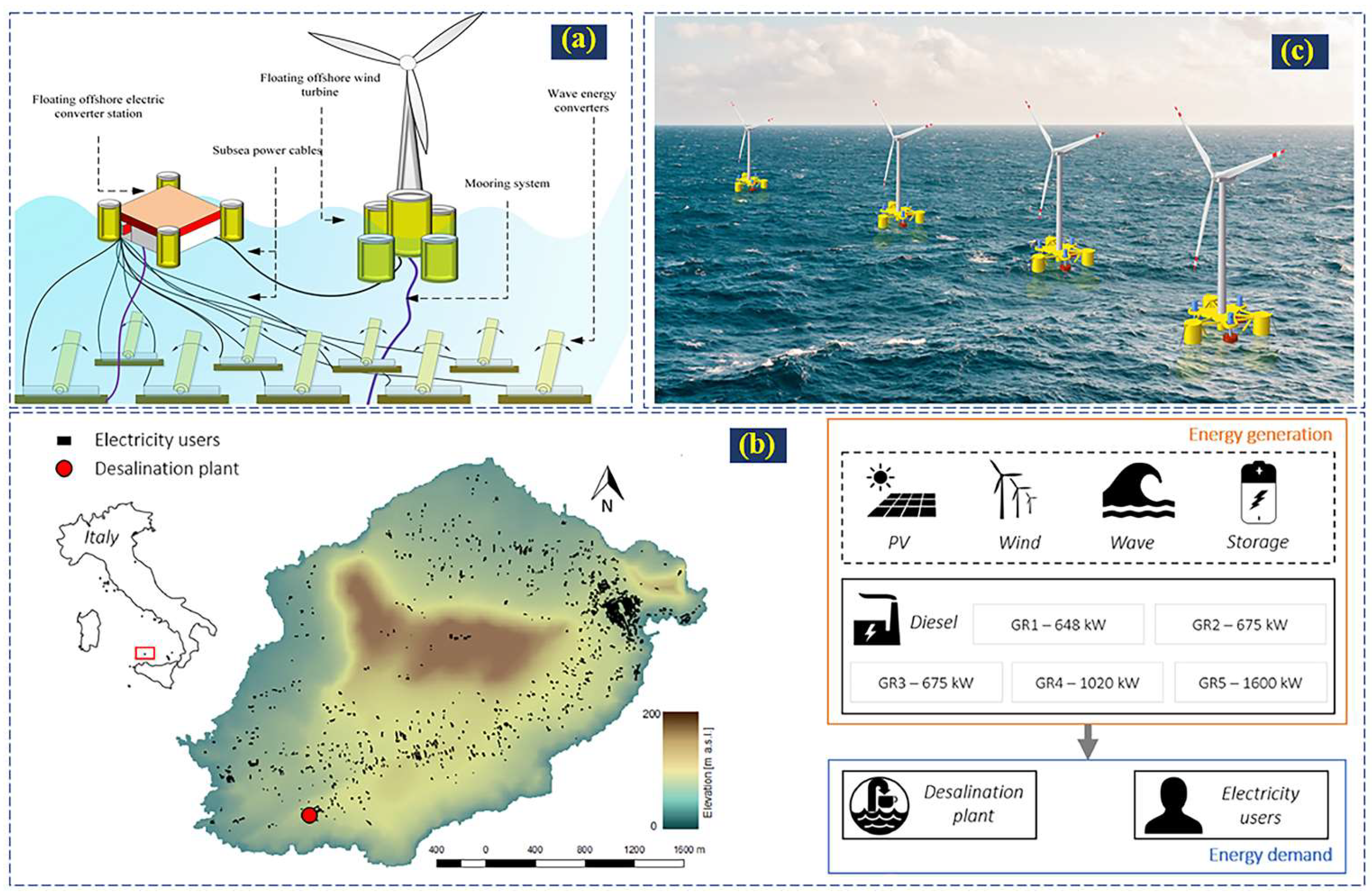





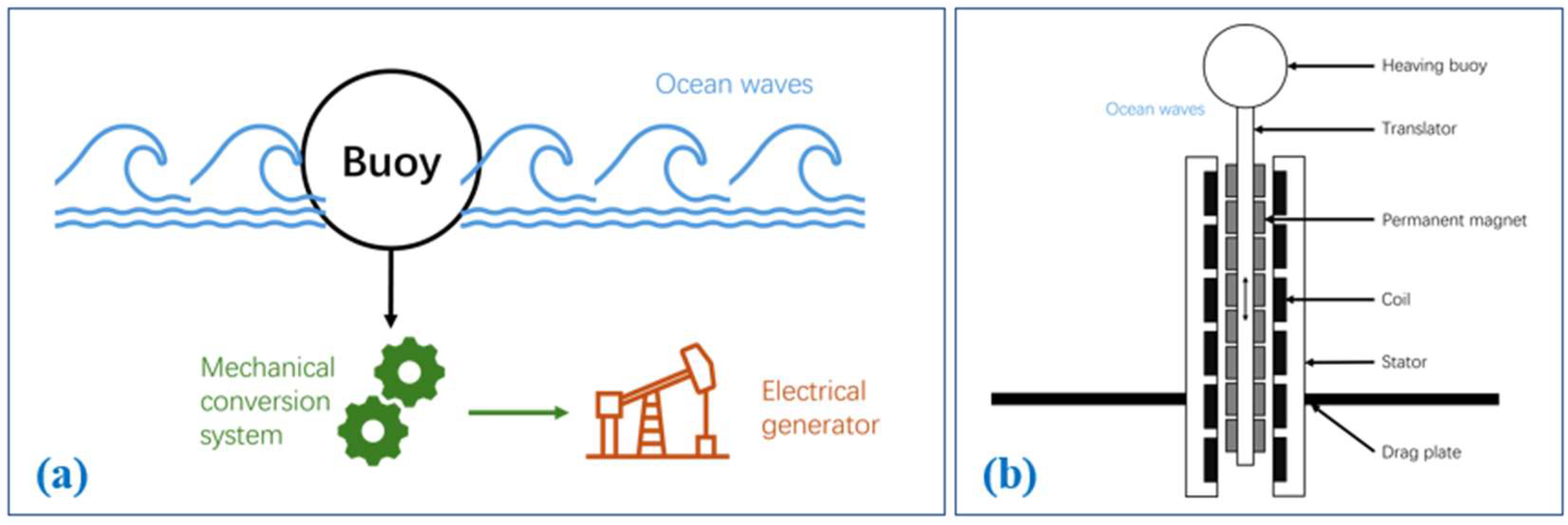
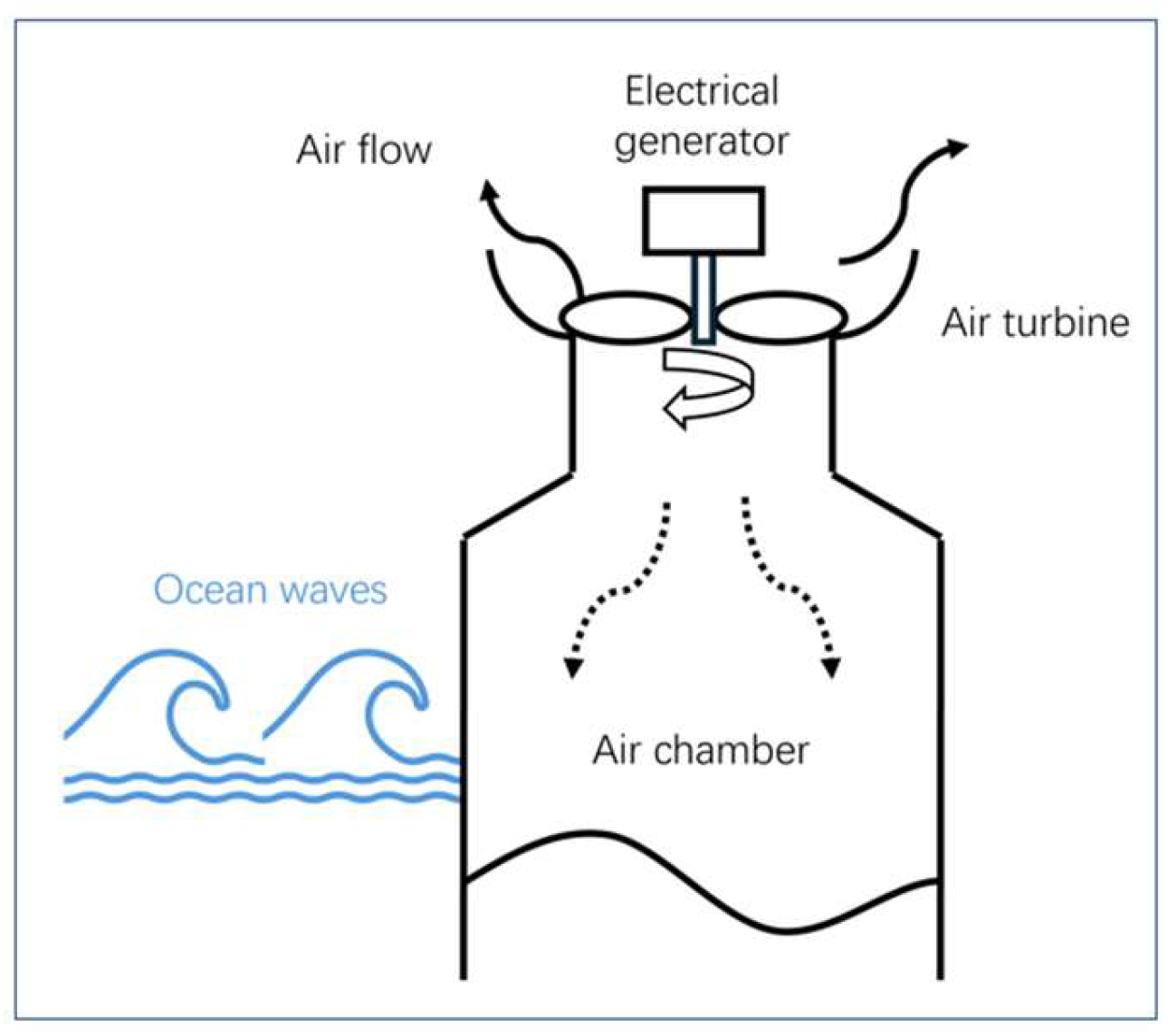

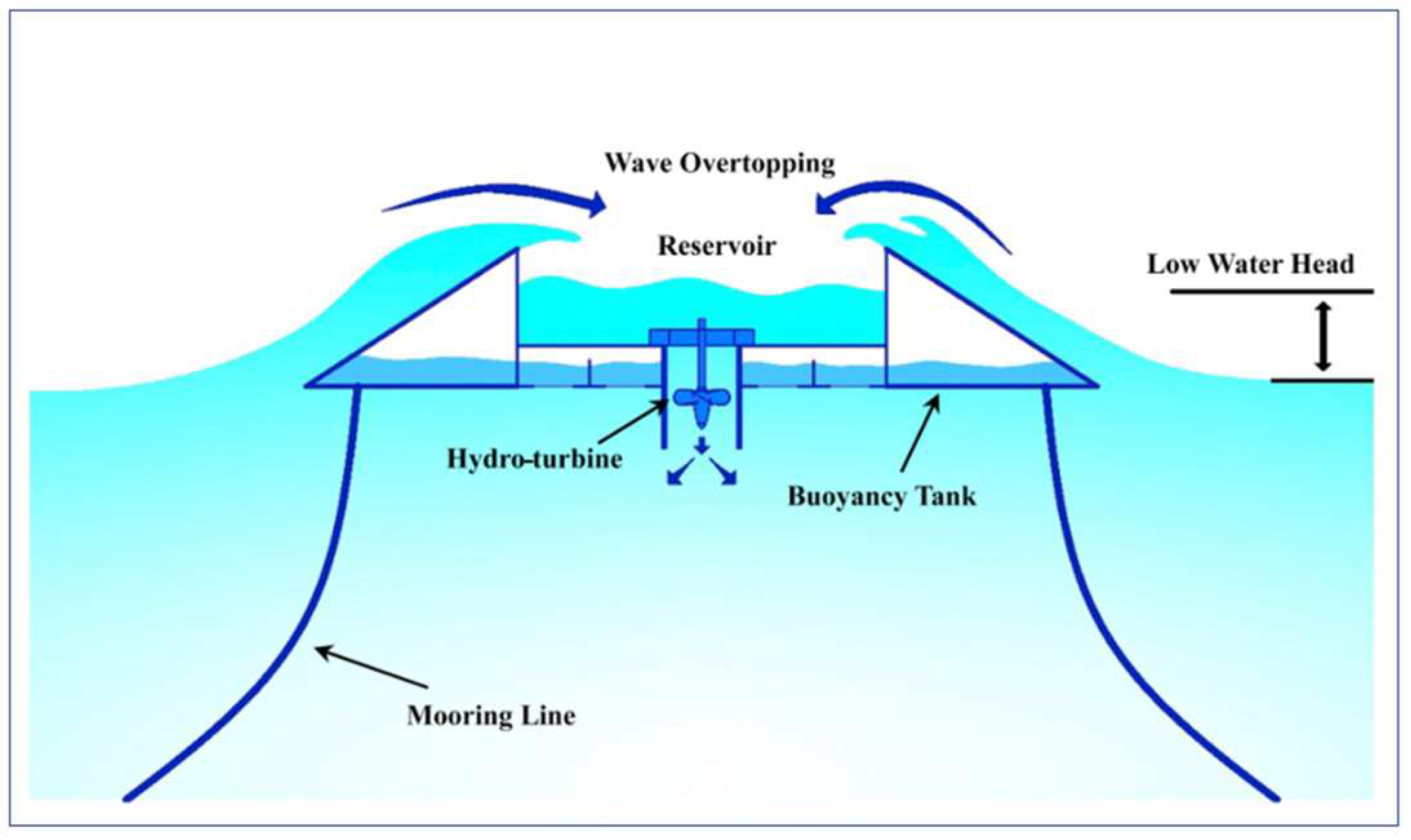



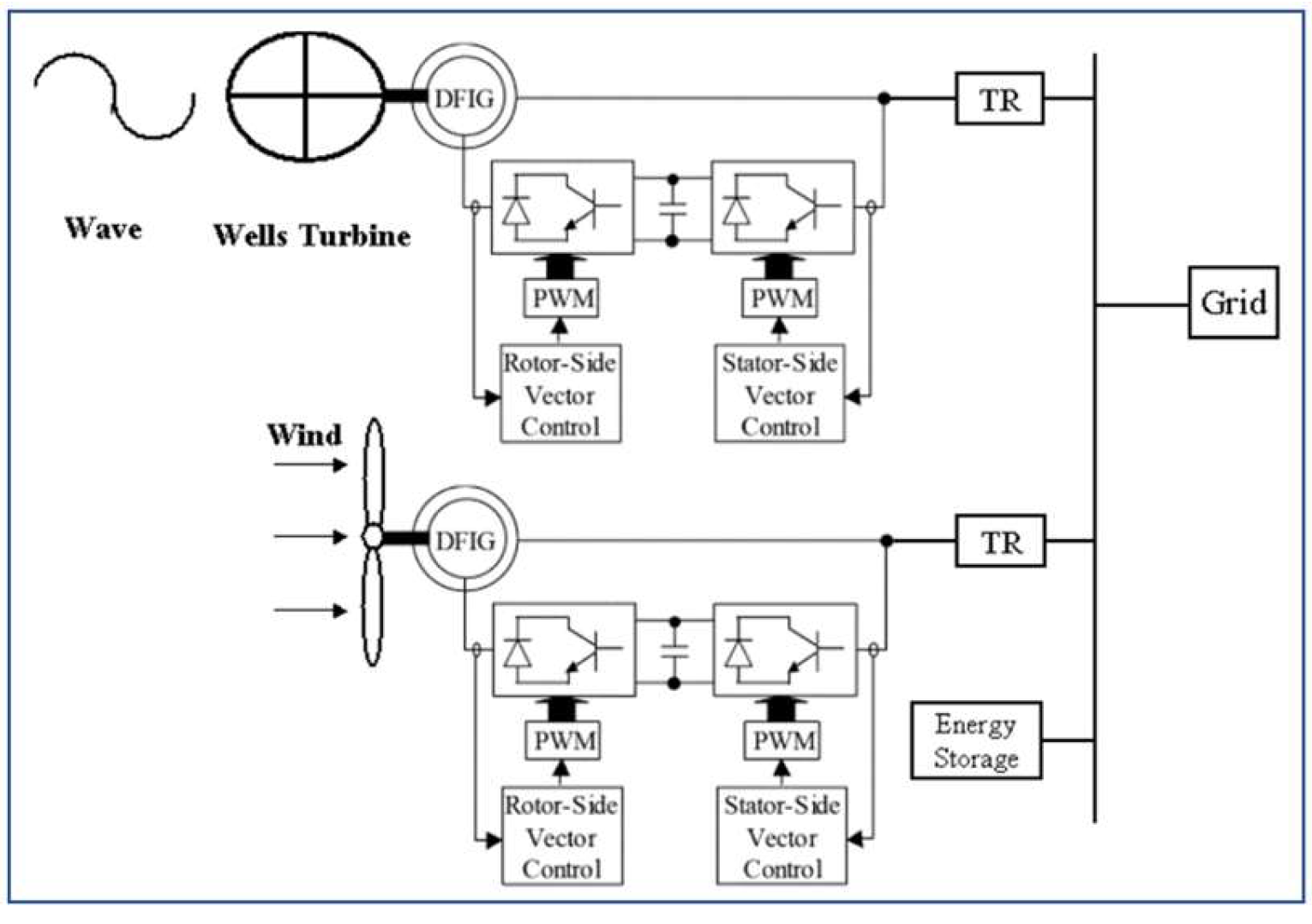
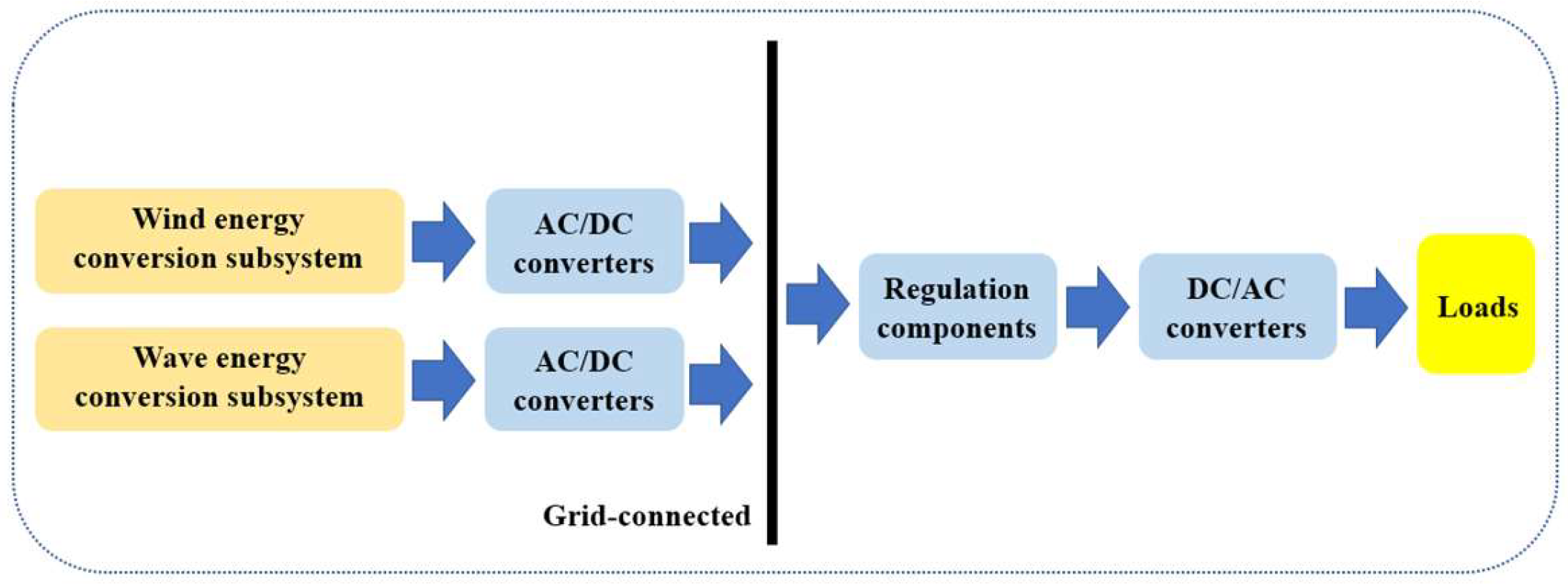
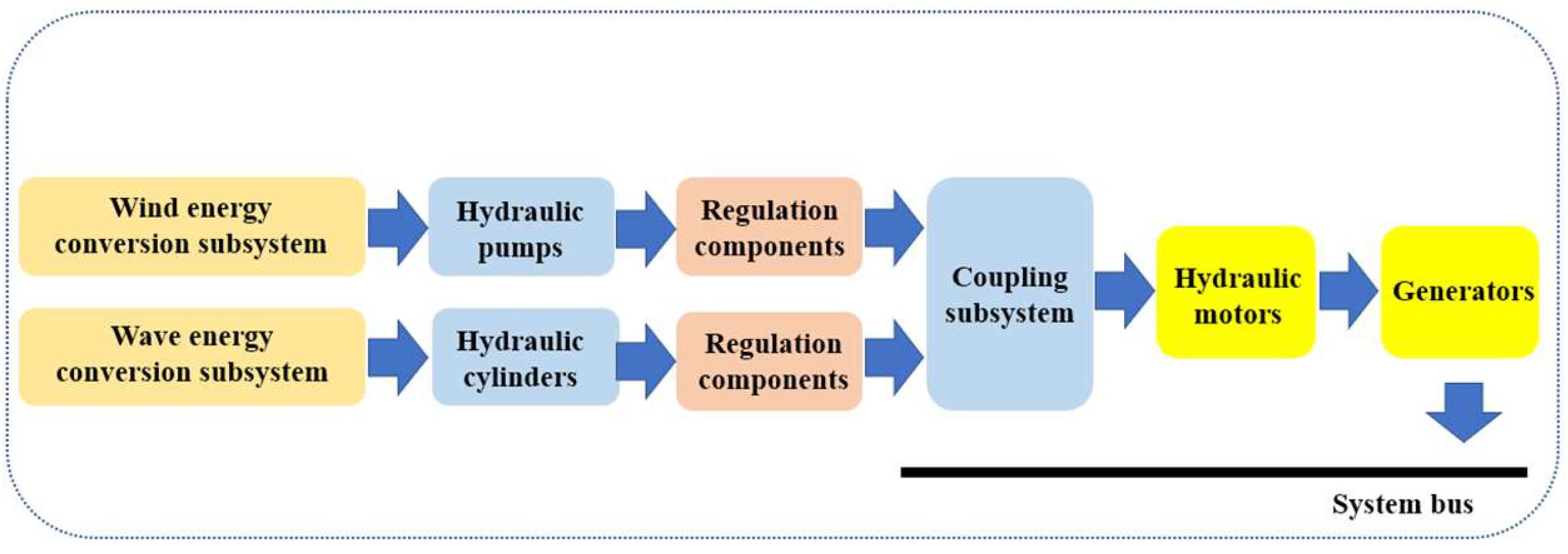
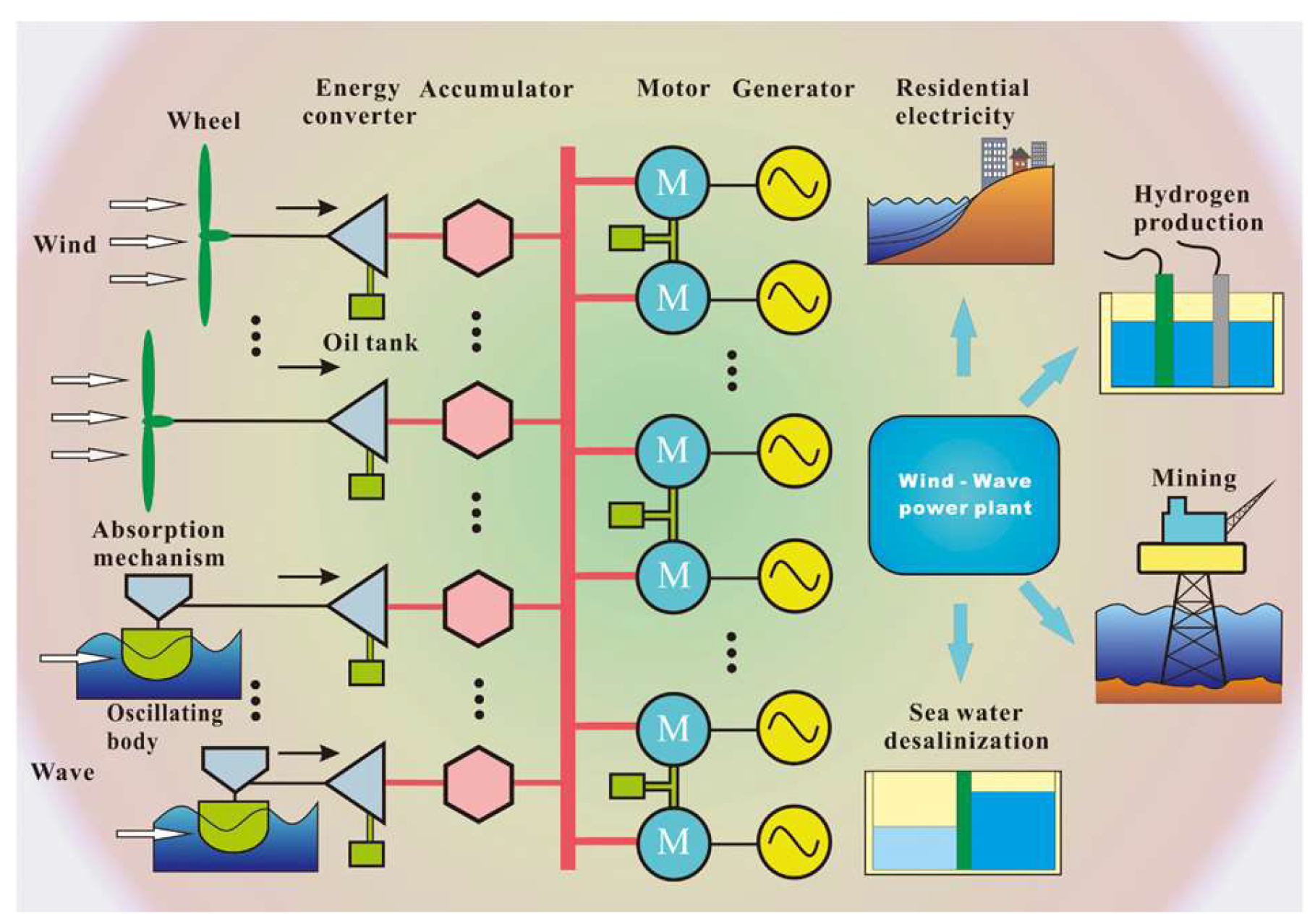


| Year | Inventor | Wind Conversion Scheme | Wave Conversion Scheme /PTO System | Energy Coupling Scheme | Capacity |
|---|---|---|---|---|---|
| 2010 | Pelagic Power AS [72] | Mechanical–electrical | OBs/hydraulic PTO | Electrical coupling | 10 MW |
| 2010 | Green Ocean Energy [71] | Mechanical–electrical | OBs/hydraulic PTO | Electrical coupling | 600 kW |
| 2011 | Principle Power Inc [74] | Mechanical–electrical | OBs/hydraulic PTO | Electrical coupling | 7 MW |
| 2012 | Wave Star AS [89] | Mechanical–electrical | OBs/hydraulic PTO | Electrical coupling | 600 kW |
| 2012 | Fiaschi et al. [113] | Mechanical–electrical | Overtopping/electrical PTO | Electrical coupling | 50 kW |
| 2013 | Shi et al. [126] | Mechanical–hydraulic | OBs/hydraulic PTO | Hydraulic coupling | 15 MW |
| 2014 | Liu et al. [131] | Mechanical–electrical | OBs/direct-drive PTO | Electrical coupling | 500 W |
| 2015 | Kim et al. [132] | Mechanical–electrical | OWCs/electrical PTO | Electrical coupling | 10 MW |
| 2016 | Chen et al. [125] | Mechanical–electrical | OBs/hydraulic PTO | Hydraulic coupling | 100 MW |
| 2017 | Moschos et al. [40] | Mechanical–electrical | Overtopping/electrical PTO | Electrical coupling | 500 kW |
| 2017 | Chen et al. [66] | Mechanical–electrical | OBs/direct-drive PTO | Electrical coupling | 5 kW |
| 2018 | Floating Power Plant [133] | Mechanical–electrical | OWCs/electrical PTO | Electrical coupling | 7 MW |
| 2019 | Sarmiento et al. [134] | Mechanical–electrical | OWCs/electrical PTO | Electrical coupling | 8 MW |
| 2020 | Zhu et al. [135] | Mechanical–electrical | OWCs/electrical PTO | Electrical coupling | 10 kW |
| 2021 | Si et al. [93] | Mechanical–electrical | OBs/hydraulic PTO | Electrical coupling | 4.7 MW |
| 2021 | Aboutalebi et al. [136] | Mechanical–electrical | OWCs/electrical PTO | Electrical coupling | 7 MW |
| 2022 | Wang et al. [63] | Mechanical–hydraulic | OBs/hydraulic PTO | Hydraulic coupling | 20 KW |
| 2023 | Zhang et al. [137] | Mechanical–hydraulic | OBs/hydraulic PTO | Hydraulic coupling | 50 KW |
| Evaluation Indexes | Mechanical–Electrical | Mechanical–Hydraulic |
|---|---|---|
| System volume | Large | Compact |
| Numbers of components | Many | Few |
| Energy conversion times | 3 times | 3 times |
| Control difficulty | Complex | Simple [79] |
| Reliability | Lower [139] | Higher |
| Transmission efficiency | lower | Higher [140] |
| Economic costs | Higher [141] | Lower |
| Technological maturity | Mature | Immature |
| Evaluation Indexes | AC Coupling | DC Coupling |
|---|---|---|
| System structure | Simple | Complex |
| Control difficulty | Simple | Difficult |
| Reliability | Lower [152] | Higher [153] |
| Innovation space | Large | Large |
| Expandability | Finite | Strong [154] |
| Fault ride-though capability | Low | Strong [155] |
| Evaluation Indexes | Electrical Coupling | Hydraulic Coupling |
|---|---|---|
| System structure | Complex | Simple |
| Storage element | Mechanical storage of battery | Accumulator |
| Adaptability | Lower | Stronger [157] |
| Transmission efficiency | Lower [158] | Higher [123] |
| Innovation space | Large | Large |
Disclaimer/Publisher’s Note: The statements, opinions and data contained in all publications are solely those of the individual author(s) and contributor(s) and not of MDPI and/or the editor(s). MDPI and/or the editor(s) disclaim responsibility for any injury to people or property resulting from any ideas, methods, instructions or products referred to in the content. |
© 2024 by the authors. Licensee MDPI, Basel, Switzerland. This article is an open access article distributed under the terms and conditions of the Creative Commons Attribution (CC BY) license (https://creativecommons.org/licenses/by/4.0/).
Share and Cite
Wang, B.; Sun, Z.; Zhao, Y.; Li, Z.; Zhang, B.; Xu, J.; Qian, P.; Zhang, D. The Energy Conversion and Coupling Technologies of Hybrid Wind–Wave Power Generation Systems: A Technological Review. Energies 2024, 17, 1853. https://doi.org/10.3390/en17081853
Wang B, Sun Z, Zhao Y, Li Z, Zhang B, Xu J, Qian P, Zhang D. The Energy Conversion and Coupling Technologies of Hybrid Wind–Wave Power Generation Systems: A Technological Review. Energies. 2024; 17(8):1853. https://doi.org/10.3390/en17081853
Chicago/Turabian StyleWang, Bohan, Zhiwei Sun, Yuanyuan Zhao, Zhiyan Li, Bohai Zhang, Jiken Xu, Peng Qian, and Dahai Zhang. 2024. "The Energy Conversion and Coupling Technologies of Hybrid Wind–Wave Power Generation Systems: A Technological Review" Energies 17, no. 8: 1853. https://doi.org/10.3390/en17081853
APA StyleWang, B., Sun, Z., Zhao, Y., Li, Z., Zhang, B., Xu, J., Qian, P., & Zhang, D. (2024). The Energy Conversion and Coupling Technologies of Hybrid Wind–Wave Power Generation Systems: A Technological Review. Energies, 17(8), 1853. https://doi.org/10.3390/en17081853







